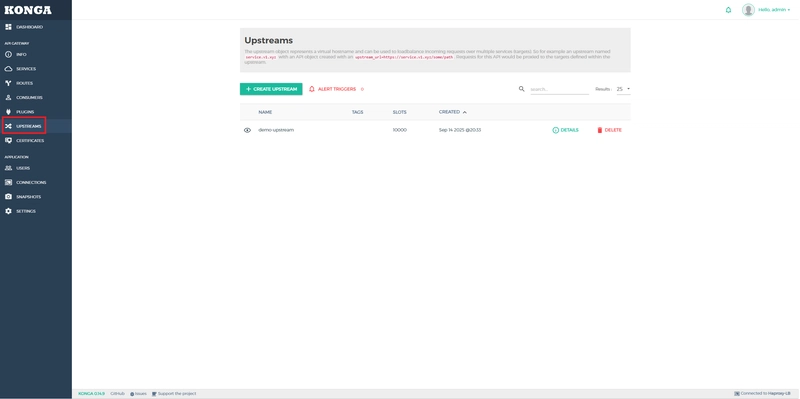What is a “Kong Cluster”?
In practice, a Kong Cluster just means you run multiple Kong gateway nodes side-by-side so traffic can:
- spread across nodes (load balancing for throughput), and
- keep flowing even if one node dies (high availability/failover).
In your setup:
- kong-1 and kong-2 are two gateway nodes.
- They share the same Postgres database (your
kong-ce-database) so they read/write the same configuration. -
HAProxy (
haproxyservice) sits in front to split incoming requests across kong-1 and kong-2.
Enterprise note (for later): Kong Enterprise supports a “hybrid” CP/DP model. For OSS/CE, clustering typically means “multiple data planes behind a load balancer using the same DB,” which is exactly what we’re doing here.
Why put a Load Balancer in front of Kong?
A load balancer (LB) like HAProxy:
- Distributes requests across nodes (round-robin by default).
- Health checks each node and stops sending traffic to unhealthy nodes (automatic failover).
- Gives you one stable endpoint to point apps at (no app-side juggling of multiple Kong hosts).
Your compose already includes HAProxy. We’ll finish it with a tiny config (your version).
You’ve done 90% of the heavy lifting. Here’s what’s in place:
- Postgres 13 for Kong (DB mode)
- One-time migrations
- Two Kong nodes (different admin/proxy ports)
- HAProxy (front door)
- Mongo + Konga (nice UI)
- (Optional) Kong Dashboard
We’ll add:
- a HAProxy config file (yours, including
X-Served-By+ admin LB), - two tiny upstream services to demonstrate failover (httpbin), and
- a Kong upstream with active health checks.
1) HAProxy: load-balance Kong nodes (your config)
Create ./haproxy/haproxy.cfg next to your compose file:
global
maxconn 4096
defaults
# keep tcp as a safe default; we'll override per section
mode tcp
timeout connect 5s
timeout client 30s
timeout server 30s
# ===== Proxy LB (9200) — must be HTTP to inject headers =====
frontend fe_proxy
bind *:9200
mode http
option forwardfor # add X-Forwarded-For for client IP
default_backend be_kong
backend be_kong
mode http
balance roundrobin
http-response add-header X-Served-By %[srv_name] # <-- shows kong1/kong2
server kong1 kong-1:8000 check inter 2000 rise 3 fall 2
server kong2 kong-2:18000 check inter 2000 rise 3 fall 2
# ===== Admin LB (9201) — leave as HTTP, no need to add headers here =====
frontend fe_admin
bind *:9201
mode http
default_backend be_admin
backend be_admin
mode http
option httpchk GET /
balance roundrobin
server kong1 kong-1:8001 check inter 2000 rise 3 fall 2
server kong2 kong-2:18001 check inter 2000 rise 3 fall 2
2) Full docker-compose.yml (merged + test apps)
Save this as your compose file (it’s your original, plus: HAProxy port
9201and two httpbin services).
# Shared Kong DB config (CE/OSS)
x-kong-config: &kong-env
KONG_DATABASE: postgres
KONG_PG_HOST: kong-ce-database
KONG_PG_DATABASE: kong
KONG_PG_USER: kong
KONG_PG_PASSWORD: kong
services:
# ------------------------------
# Postgres 13 for Kong (CE/OSS)
# ------------------------------
kong-ce-database:
image: postgres:13
container_name: kong-ce-database
environment:
POSTGRES_USER: kong
POSTGRES_DB: kong
POSTGRES_PASSWORD: kong
volumes:
- kong_db_data:/var/lib/postgresql/data
networks: [kong-ce-net]
ports:
- "5432:5432" # optional: expose for local access
healthcheck:
test: ["CMD-SHELL", "pg_isready -U kong -d kong"]
interval: 10s
timeout: 5s
retries: 20
restart: unless-stopped
# ------------------------------
# One-time Kong migrations
# ------------------------------
kong-migrations:
image: kong:3.9.1
container_name: kong-migrations
depends_on:
kong-ce-database:
condition: service_healthy
environment:
<<: *kong-env
entrypoint: >
/bin/sh -lc
"kong migrations bootstrap -v || (kong migrations up -v && kong migrations finish -v)"
networks: [kong-ce-net]
restart: "no"
# ------------------------------
# Kong Gateway node #1
# ------------------------------
kong-1:
image: kong:3.9.1
container_name: kong-1
depends_on:
kong-ce-database:
condition: service_healthy
kong-migrations:
condition: service_completed_successfully
environment:
<<: *kong-env
KONG_ADMIN_LISTEN: "0.0.0.0:8001,0.0.0.0:8444 ssl"
ports:
- "8000:8000" # proxy
- "8443:8443" # proxy ssl
- "8001:8001" # admin
- "8444:8444" # admin ssl
healthcheck:
test: ["CMD", "kong", "health"]
networks: [kong-ce-net]
restart: unless-stopped
# ------------------------------
# Kong Gateway node #2 (different internal ports)
# ------------------------------
kong-2:
image: kong:3.9.1
container_name: kong-2
depends_on:
kong-ce-database:
condition: service_healthy
kong-migrations:
condition: service_completed_successfully
environment:
<<: *kong-env
KONG_ADMIN_LISTEN: "0.0.0.0:18001,0.0.0.0:18444 ssl"
KONG_PROXY_LISTEN: "0.0.0.0:18000,0.0.0.0:18443 ssl"
ports:
- "8002:18000" # proxy (host)
- "18443:18443" # proxy ssl (host)
- "18001:18001" # admin (host)
- "18444:18444" # admin ssl (host)
healthcheck:
test: ["CMD", "kong", "health"]
networks: [kong-ce-net]
restart: unless-stopped
# ------------------------------
# HAProxy to load-balance kong-1 / kong-2
# ------------------------------
haproxy:
image: haproxy:2.9
container_name: kong-haproxy
networks: [kong-ce-net]
depends_on:
kong-1:
condition: service_started
kong-2:
condition: service_started
ports:
- "9200:9200" # proxy LB
- "9201:9201" # admin LB
volumes:
- ./haproxy/haproxy.cfg:/usr/local/etc/haproxy/haproxy.cfg:ro
command: ["/usr/local/sbin/haproxy","-f","/usr/local/etc/haproxy/haproxy.cfg","-db"]
restart: unless-stopped
# ------------------------------
# MongoDB 4.4 for Konga
# ------------------------------
mongo:
image: mongo:4.4
container_name: mongo
volumes:
- mongo_data:/data/db
networks: [kong-ce-net]
ports:
- "27017:27017" # optional
healthcheck:
test: ["CMD", "mongo", "--eval", "db.runCommand({ ping: 1 })"]
interval: 10s
timeout: 5s
retries: 20
restart: unless-stopped
# ------------------------------
# Konga DB prepare (Mongo)
# ------------------------------
konga-prepare:
image: pantsel/konga:latest
container_name: konga-prepare
depends_on:
mongo:
condition: service_healthy
command: -c prepare -a mongo -u mongodb://mongo:27017/konga
networks: [kong-ce-net]
restart: "no"
# ------------------------------
# Konga (Admin UI) on Mongo
# ------------------------------
konga:
image: pantsel/konga:latest
container_name: konga
depends_on:
mongo:
condition: service_healthy
konga-prepare:
condition: service_completed_successfully
environment:
DB_ADAPTER: mongo
DB_HOST: mongo
DB_PORT: 27017
DB_DATABASE: konga
NODE_ENV: production
ports:
- "1337:1337"
networks: [kong-ce-net]
restart: unless-stopped
# ------------------------------
# KongDash (optional)
# ------------------------------
kongdash:
image: pgbi/kong-dashboard:v2
container_name: kongdash
command: ["start", "--kong-url", "http://kong-1:8001"]
depends_on:
kong-1:
condition: service_started
ports:
- "8085:8080"
networks: [kong-ce-net]
restart: unless-stopped
# ------------------------------
# Test upstream apps for failover
# ------------------------------
httpbin1:
image: mccutchen/go-httpbin:v2.15.0
container_name: httpbin1
networks: [kong-ce-net]
restart: unless-stopped
httpbin2:
image: mccutchen/go-httpbin:v2.15.0
container_name: httpbin2
networks: [kong-ce-net]
restart: unless-stopped
volumes:
kong_db_data: {} # Postgres data for Kong
mongo_data: {} # Mongo data for Konga
networks:
kong-ce-net:
driver: bridge
Bring everything up:
docker compose up -d
3) Configure Kong (via Admin API) for upstream failover
We’ll create:
- an Upstream (logical name) with
- two Targets (
httpbin1&httpbin2), plus - active health checks so Kong can remove a bad target automatically,
- a Service pointing to the upstream, and
- a Route to expose it.
Run these against either Admin API (e.g.
http://localhost:8001for kong-1 orhttp://localhost:18001for kong-2).
3.1 Upstream with health checks
curl -sS -X POST http://localhost:8001/upstreams \
-H "Content-Type: application/json" \
-d '{
"name": "demo-upstream",
"healthchecks": {
"active": {
"http_path": "/status/200",
"timeout": 1,
"healthy": { "interval": 5, "successes": 1 },
"unhealthy": { "interval": 5, "http_failures": 1, "tcp_failures": 1, "timeouts": 1 }
}
}
}'
In Konga -> UPSTREAMS
3.2 Register the two targets
curl -sS -X POST http://localhost:8001/upstreams/demo-upstream/targets \
-H "Content-Type: application/json" \
-d '{"target":"httpbin1:8080","weight":100}'
curl -sS -X POST http://localhost:8001/upstreams/demo-upstream/targets \
-H "Content-Type: application/json" \
-d '{"target":"httpbin2:8080","weight":100}'
In Konga -> UPSTREAMS -> Click at Detail
Then Click Targets
3.3 Create a Service using the upstream
curl -sS -X POST http://localhost:8001/services \
-H "Content-Type: application/json" \
-d '{"name":"demo-svc","host":"demo-upstream","port":8080,"protocol":"http"}'
In Konga -> Service
3.4 Expose it with a Route
curl -sS -X POST http://localhost:8001/services/demo-svc/routes \
-H "Content-Type: application/json" \
-d '{"name":"demo-route","paths":["/demo"]}'
In Konga -> Route
demo-route will set as a Route
Your app endpoint (through HAProxy → Kong) is:
http://localhost:9200/demo/get
Basic test:
curl -i http://localhost:9200/demo/get
# expect 200 + an X-Served-By header from HAProxy: kong1 or kong2
1). Open http://localhost:1337 and create an admin user.
2). Add a Connection (point Konga at the admin LB):
In Konga -> CONNECTIONS -> Click button [+ NEW CONNECTION]
Enter the following detail
-
Name:
Haproxy-LB -
Kong Admin URL:
http://localhost:9201 - Username: Your Konga Username
- Password: Your Konga Password
3). In Konga, you can build the same objects via UI:
-
Upstreams → Add Upstream (
demo-upstream) -
Targets → Add Target (
httpbin1:8080,httpbin2:8080) -
Services → Add Service (
demo-svc, host:demo-upstream, port8080) -
Routes → Add Route (
demo-route, paths:/demo) -
Healthchecks: enable Active checks with path
/status/200.
Either method (API or Konga) updates the shared Postgres DB, so both Kong nodes use the same config.
A) Gateway node failover (HAProxy removes bad Kong)
See which node served you:
curl -i http://localhost:9200/status | grep -i X-Served-By
Kill one Kong node:
docker stop kong-1
for i in {1..6}; do curl -sI http://localhost:9200/status | grep -i X-Served-By; done
# expect only kong2 now
docker start kong-1
By killing Kong-1, only Kong-2 remains running. All the load will then go to Kong-2 instead of Kong-1, which is down. I then restarted Kong-1, and this time the load was distributed between Kong-1 and Kong-2.
B) Upstream target failover (Kong removes bad target)
# both targets healthy?
curl -sS http://localhost:8001/upstreams/demo-upstream/health | jq .
# stop one target
docker stop httpbin1
# calls should still return 200 (served by httpbin2)
for i in {1..6}; do curl -s -o /dev/null -w "%{http_code}\n" http://localhost:9200/demo/get; done
# health should show httpbin1 UNHEALTHY
curl -sS http://localhost:8001/upstreams/demo-upstream/health | jq .
# recover
docker start httpbin1
First, I checked the upstream health status:curl -sS http://localhost:8001/upstreams/demo-upstream/health | jq .
At this point, only httpbin2 was healthy and available.
Next, I sent 6 requests to the service:
for i in {1..6}; do curl -s -o /dev/null -w "%{http_code}\n" http://localhost:9200/demo/get; done
All requests were routed successfully to httpbin2, since httpbin1 was still down.
I then verified the upstream health again:
curl -sS http://localhost:8001/upstreams/demo-upstream/health | jq .
The results confirmed that only httpbin2 was handling traffic.
After that, I restarted httpbin1:docker start httpbin1
Finally, I checked the upstream health one more time:curl -sS http://localhost:8001/upstreams/demo-upstream/health | jq .
Now both httpbin1 and httpbin2 were healthy, so the load could be distributed across both instances again.
-
Konga can’t reach Admin API? Use the admin LB:
http://localhost:9201. -
HAProxy 503? Check
haproxylogs and verify both admins & proxies:
curl http://localhost:8001/status
curl http://localhost:18001/status
- DB is a single point of failure in this demo. For real HA, use a managed Postgres/cluster or explore DB-less with declarative config + an external config store.
-
Health checks too slow/fast? Tweak
interval/thresholds in the Upstreamhealthchecks.active.
- A two-node Kong cluster (OSS) sharing one Postgres DB.
-
HAProxy in front for node-level load balancing and failover (proxy
:9200, admin:9201withX-Served-By). - A Kong Upstream with active health checks for service-level failover between two targets.
- Konga as a friendly admin UI.


















